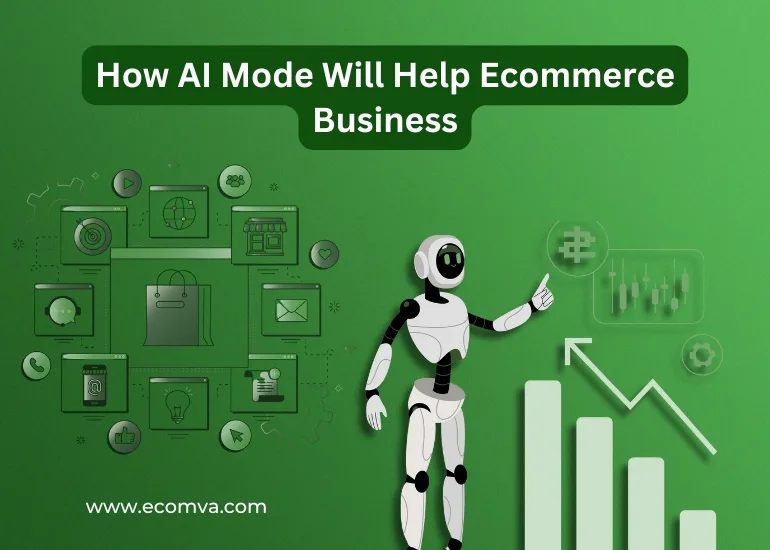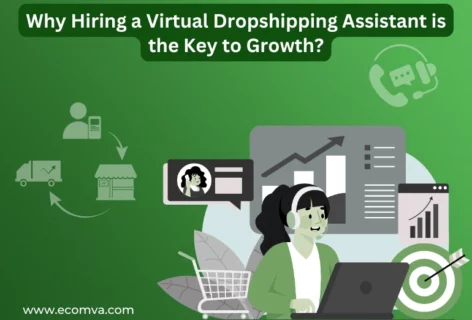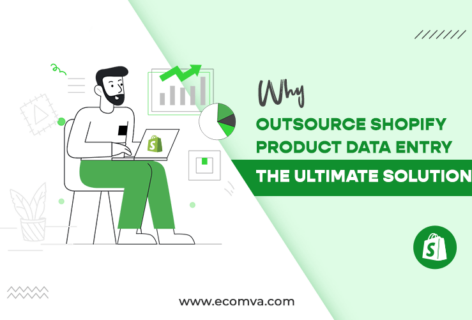How AI Mode Will Help Ecommerce Business

Ecommerce has grown into a fast-paced, data-heavy space where manual, solo work is no longer enough. Business owners are facing pressure to respond quickly, manage stock efficiently, and offer seamless experiences across all touchpoints. This is where AI Mode is making a difference.
AI Mode isn’t a feature limited to large corporations anymore. It’s now used by small and mid-sized online sellers who want to
- Simplify operations
- Reduce errors
- Work more efficiently
It helps with decisions, speeds up processes, and automates repetitive tasks in real time.
To get even more out of it, many businesses are taking the help of an ecommerce virtual assistant, who can help manage smart software and provide task-specific support to handle daily store operations.
Let’s break down how AI Mode is helping ecommerce businesses work smarter and grow faster in 2025, and how it integrates naturally with various support tools available today.
The Role of AI Mode in Ecommerce Operations
AI Mode refers to systems that can perform tasks based on patterns, rules, and real-time data without constant human input. These systems are built into ecommerce platforms, analytics tools, customer support systems, and backend inventory solutions.
Instead of waiting for a store manager to notice an issue or make a change, AI Mode systems detect the problem and act automatically. This results in:
- Faster response times
- Fewer order errors
- Better inventory planning
- Smart suggestions for pricing or marketing
By making real-time decisions, these systems help businesses avoid delays and cut down the amount of admin work needed each day.
Why More Businesses Are Switching to Smarter Systems
Time is the most limited resource in ecommerce. Owners are pulled in multiple directions—orders, returns, messages, product uploads, and marketing. AI Mode simplifies many of these processes, making day-to-day operations smoother and more reliable.
For example, AI can:
- Predict when a product might go out of stock
- Automatically adjust pricing based on demand
- Send follow-ups to customers who abandon carts
- Sort customer service requests by priority
These tasks used to take hours or a full-time staff member. Now they’re handled instantly or with the help of a VA.
Even businesses that use an ecommerce virtual assistant find that combining AI-powered systems with human support reduces response time, improves accuracy, and frees up resources for growth.
Where AI Mode Is Making the Biggest Difference
AI-Powered Inventory and Product Management
One of the most important uses of AI Mode is in inventory and catalog management. It tracks product availability, supplier restocks, sales velocity, and demand forecasting. If stock is running low, it can trigger alerts or auto-reorder actions.
Using an inventory management assistant connected to AI Mode, a business can:
- Reduce stockouts and overstocking
- Track high-velocity items in real time
- Sync inventory across multiple sales channels
- Prevent order delays due to low stock
According to Retail Systems Research, 45% of ecommerce sellers reported that AI-based inventory tracking reduced stock-related errors by over 30%.
Smarter Customer Service Without More Staff
Customer support is one of the areas where delays are costly. Late replies lead to bad reviews or lost customers. AI Mode solves this by categorizing and routing messages, generating instant responses, and learning from past interactions.
Some businesses set this up through their helpdesk platforms or by using an online store virtual assistant trained with customer interaction data. This system can handle:
- Order status requests
- Refund and return processes
- Basic product questions
- FAQ-style support across chat, email, or contact forms
Instead of hiring three more agents, stores now build support layers that combine AI assistance and live staff only where needed.
Making Data-Backed Decisions with Less Guesswork
AI Mode tools don’t just execute tasks—they also collect, sort, and analyze large amounts of business data. That data is then used to:
- Understand buyer behavior
- Suggest optimal times to launch promotions
- Adjust pricing based on demand or competitor shifts
- Predict return rates or problem orders
These insights help ecommerce owners make smarter decisions with less guesswork. For example, if data shows that certain products always spike in demand after payday, the system can automatically promote those products at the right time.
Some store owners use a virtual assistant for ecommerce entrepreneurs to review data summaries, flag inconsistencies, and provide guidance on where to focus next.
To see the real-world impact of switching to AI Mode, here’s a side-by-side comparison of what key tasks look like with and without automation.
Manual vs AI Mode in Key Business Areas
| Business Area | Manual Workflow | AI Mode Workflow |
|---|---|---|
| Inventory Tracking | Staff checks levels and updates | Auto-monitors stock and sends alerts |
| Customer Inquiries | Team responds to each message | AI drafts replies, routes messages by urgency |
| Order Processing | Updates sent manually | AI confirms orders and triggers shipment flows |
| Pricing Decisions | Manual market research | AI analyses trends and adjusts pricing |
How Does AI Mode Complement Human Effort?
One of the biggest misconceptions is that AI Mode replaces people. That’s not true. In most ecommerce businesses, it supports people by doing routine tasks faster and more accurately.
With an ecommerce automation assistant, a small team can manage the workload of what used to require double the staff. This includes:
- Scheduling emails based on customer behavior
- Recommending upsells based on order history
- Identifying abandoned cart patterns
- Managing loyalty program engagement
When automation handles these touchpoints, team members are free to work on product development, partnerships, or creative work that drives the business forward.
How Much Time and Effort AI Mode Can Actually Save
| Business Size | Manual Handling (Avg Hours/Week) | AI Mode (Avg Hours/Week) | Time Saved |
|---|---|---|---|
| Small (1-2 people) | 45 | 22 | 23 hours |
| Mid-sized (3-8) | 80 | 48 | 32 hours |
| Large (10+) | 120 | 75 | 45 hours |
How Can You Scale Smart with AI Mode?
As AI Mode continues to expand, it’s becoming more common in areas like:
- Real-time fraud detection
- Multi-channel selling synchronization
- Personalized shopping experiences
- Post-purchase experience tracking
The difference it makes isn’t just about speed. It’s also about reducing risk—fewer errors in orders, fewer delays in shipping, and fewer missed opportunities to engage with a buyer.
If you run a Shopify, WooCommerce, or custom store setup, chances are high that you already have access to AI-based tools. Pairing them with a reliable ecommerce virtual assistant helps bring that system full circle.
Getting Started with AI Mode in Your Store
You don’t need to transform your entire business overnight. A smart approach is to:
- Start with order processing or customer support
- Add inventory and restocking features next
- Layer on pricing, reviews, or email scheduling
- Review reports weekly to adjust automation rules
Most platforms offer trial versions of tools that work as an online store virtual assistant, or you can hire a part-time support staff to manage AI-based systems on your behalf.
Take One Step Ahead!
AI Mode isn’t about replacing your role as the business owner—it’s about making sure your business runs efficiently, accurately, and consistently while you focus on growth.
If you’re spending hours every week answering emails, editing product info, or checking stock, it might be time to shift to tools that work faster and smarter. Whether you choose to bring on a virtual assistant for ecommerce entrepreneurs or test an ecommerce automation assistant, the result is the same: happier customers, fewer errors, and more time for you to grow the business.
At EcomVA, we help ecommerce brands like yours simplify their operations using experienced virtual assistants and purpose-built automation strategies. From inventory management to customer support, our team works as an extension of yours. Hence, you can scale without being overwhelmed.
Smart systems are no longer optional. In 2025, they’re becoming the new standard. Let EcomVA help you get there faster.
FAQs
1. Is AI Mode suitable for stores with low sales volume or fewer products?
Yes, it can. Even if you’re running a small store with just a few products, AI Mode can save you loads of time. Things like replying to customers, managing orders, or updating stock don’t need to be done manually anymore. It’s a smart way to stay organised without hiring extra help.
2. Can AI Mode help with multi-language customer support?
They sure can. A lot of AI tools today are built to understand and respond in multiple languages. So if you’re selling to international customers, these tools can reply in their language and make your store feel more local, without you needing to speak five different languages.
3. What are the risks of relying too much on automation in ecommerce?
While AI Mode can handle a lot, it’s still smart to check in on things now and then. If a product is mislabelled or an order slips through the cracks, someone still needs to catch it. The best approach is to use AI for the repetitive stuff, but keep a human eye on key areas.
4. Do I need to hire a developer to implement AI Mode tools?
Not really. Most of the tools out there are pretty easy to plug into your store—no coding needed. And if you’re not sure where to start, that’s where EcomVA can help. We’ll walk you through the setup, show you what to automate, and even manage it for you if you like.










